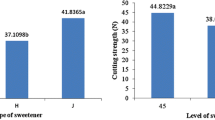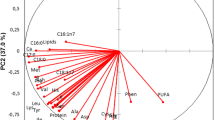Abstract
Foam-topped cacao and maize beverages have a long history in Mesoamerica. Tejate is such a beverage found primarily in the Zapotec region of the Central Valleys of Oaxaca, Mexico. Historically tejate has been ceremonially important but also as an essential staple, especially during periods of hard fieldwork. However, the nutritional contribution of traditional foods such as tejate has not been investigated. We analyzed tejate samples from three Central Valley communities, vendors in urban Oaxaca markets and one migrant vendor in California, USA for their proximate composition, amino acid content and scores, and mineral and methylxanthine content. Nutritional and chemical variation exists among tejate recipes, however, the beverage is a source of energy, fat, methylxanthines, K, Fe and other minerals although their availability due to presence of phytates remains to be determined. Tejate is a source of protein comparable to an equal serving size of tortillas, with protein quality similarly limited in both. Tejate provides the nutritional benefits of maize, and some additional ones, in a form appealing during hot periods of intense work, and year round because of its cultural significance. Its substitution by sodas and other high glycemic beverages may have negative nutritional, health and cultural consequences.

Similar content being viewed by others
References
Henderson JS, Joyce RA, Hall GR, Hurst WJ, McGovern PE (2007) Chemical and archaeological evidence for the earliest cacao beverages. PNAS 104:18937–18940
Powis TG, Valdez F, Hester TR, Hurst WJ, Tarka SM (2002) Spouted vessels and cacao use among the preclassic Maya. Lat Am Antiq 13:85–106
Sahagún Bd (1988) Historia General de las Cosas de Nueva España, 1547–1582. Alianza Editorial, Madrid
Green JS (2009) Feasting with foam: Ceremonial drinks of cacao, maize, and pataxte cacao. In: Staller JE, Carrasco MD (eds) Pre-columbian Foodways: Interdisciplinary Approaches to Food, Culture, and Markets in Ancient Mesoamerica. Springer Science+Business Media, New York, pp 315–343
McNeil CL (2006) Traditional cacao use in modern Mesoamerica. In: McNeil CL (ed) Chocolate in Mesoamerica. University of Florida Press, Gainesville, pp 341–366
Soleri D, Cleveland DA, Aragón Cuevas F (2008) Food globalization and local diversity: The case of tejate, a traditional maize and cacao beverage from Oaxaca, Mexico. Curr Anthropol 49:281–290
González Esperón LM (2006) El Tejate: Una Bebida Prehispánica. Secretaría de Cultura del Estado de Oaxaca, Oaxaca, Oax
Popkin BM (2006) Global nutrition dynamics: The world is shifting rapidly toward a diet linked with noncommunicable diseases. Am J Clin Nutr 84:289–298
Consejo Indígena Popular de Oaxaca “Ricardo Flores Magón” (2002) La Lucha en Oaxaca del Consejo Indígena Popular. http://www.ecoportal.net/noti02/n488.htm#. Accessed 7 February 2006
Weiner T (2002) McTaco vs. fried crickets: A duel in the Oaxaca sun. New York Times, 2002 August 24, p 2
Guyot J-P, Trèche S, Rio D, Espinosa J, Centurión D, Wacher C (2003) Pozol, a popular Mexican traditional beverage made from a fermented alkaline cooked maize dough. 2nd International Workshop on Food-Based Approaches for Healthy Nutrition, 23–28 November, 2003. Ouagadougou
Wacher C, Cañas A, Bárzana E, Lappe P, Ulloa M, Owens JD (2000) Microbiology of Indian and Mestizo pozol fermentations. Food Microbiol 17:251–256
INEGI (2005) Conteo de Población y Vivienda 2005. (INEGI) Instituto Nacional de Estadística y Geografía. http://www.inegi.org.mx/sistemas/consulta_resultados/default.aspx?c=10395&s=est. Accessed 3 June 2010
AOAC (1995) Official Methods of Analysis of AOAC International, 16th Edition, vol I and II. Association of Official Analytical Chemists (AOAC), Arlington
Bidlingmeyer BA, Cohen SA, Tarvin TL (1984) Rapid analysis of amino acids using pre column derivatization. J Chromatogr 336:93–104
Cohen S, Michaud D (1993) Synthesis of a fluorescent derivatizing reagent, 6-aminoquinolyl-N-hydroxysuccinimidyl carbamate, and its application for the analysis of hydrolysate amino acids via HPLC. Anal Biochem 211:279–287
Lucas B, Sotelo A (1980) Effect of different alkalies, temperature, and hydrolysis times on tryptophan determination of pure proteins and of foods. Anal Biochem 109:192–197
Yust M, Pedroche J, Girón-Calle J, Vioque J, Millán F, Alais M (2004) Determination of tryptophan by high performance liquid chromatography of alkaline hydrolysates with spectrophotometric detection. Food Chem 85:317–320
SAS Institute (2002–2011) Statistical Analysis System 9.2. SAS Institute, Inc, Cary
Vázquez-Carrillo G, García-Lara S, Salinas-Moreno Y, Bergvinson DJ, Palacios-Rojas N (2011) Grain and tortilla quality in landraces and improved maize grown in the highlands of Mexico. Plant Foods Hum Nutr 66:203–208
Schenker S (2000) The nutritional and physiological properties of chocolate. Nutr Bull 25:303–313
del Rosario BM, Gutiérrez L, Delgado Y, Gallignani M, Zambrano A, Gómez Á, Ramos G, Romero C (2007) Determination of theobromine, theophylline and caffeine in cocoa samples by a high-performance liquid chromatographic method with on-line sample cleanup in a switching-column system. Food Chem 100:459–467
Sotelo A, Alvarez RG (1991) Chemical composition of wild Theobroma species and their comparison to the cacao bean. J Agric Food Chem 39:1940–1943
Tovar L, Olivos M, Gutierrez M (2008) Pulque, an alcoholic drink from rural Mexico, contains phytase. Its in vitro effects on corn tortilla. Plant Foods Hum Nutr 63:189–194
Mitchikpe ECS, Dossaa RAM, Ategbob E-AD, van Raaijc JMA, Hulshofc PJM, Kok FJ (2008) The supply of bioavailable iron and zinc may be affected by phytate in Beninese children. J Food Comp Anal 21:17–25
FAO/WHO/ONU (2002) Protein and amino acid requirements in human nutrition: Report of a joint FAO/WHO/UNU expert consultation, vol 935. WHO technical report series. World Health Organization, Geneva
USDA (2010) USDA National Nutrient Database for Standard Reference. Release 23. USDA. http://www.nal.usda.gov/fnic/foodcomp/cgi-bin/list_nut_edit.pl. Accessed 15 February 2011
Pappa MR, Palacios de Palomo P, Bressani R (2010) Effect of lime and wood ash on the nixtamalization of maize and tortilla chemical and nutritional characteristics. Plant Foods Hum Nutr 65:130–135
Rusconi M, Conti A (2010) Theobroma cacao L., the food of the gods: A scientific approach beyond myths and claims. Pharmacol Res 61:5–13
Borchers AT, Keen CL, Hannum SM, Gershwin ME (2000) Cocoa and chocolate: Composition, bioavailability and health implications. J Med Food 3:77
Denova-Gutiérrez E, Jiménez-Aguilar A, Halley-Castillo E, Huitrón-Bravo G, Talavera JO, Pineda-Pérez D, Díaz-Montiel JC, Salmerón J (2008) Association between sweetened beverage consumption and body mass index, proportion of body fat and body fat distribution in Mexican adolescents. Ann Nutr Metab 53:245–251
Rivera JA, Barquera S, Campirano F, Campos I, Safdie M, Tovar V (2002) Epidemiological and nutritional transition in Mexico: Rapid increase of non-communicable chronic diseases and obesity. Pub Health Nutr 5:113–122
Barquera S, Hernandez-Barrera L, Tolentino ML, Espinosa J, Ng SW, Rivera JA, Popkin BM (2008) Energy intake from beverages is increasing among Mexican adolescents and adults. J Nutr 138:2454–2461
ANPRAC (2009) La Industria de refrescos y Aguas Carbonatadas en 2008. ANPRAC (Asociación Nacional de Productores de Refrescos y Aguas Carbonatadas), México D.F.
Kuhnlein HV, Receveur O (1996) Dietary change and traditional food systems of indigenous peoples. Annu Rev Nutr 16:417–442
Bourges Rodríguez H, Morales de León J, Camacho Parra ME, Escobedo Olea G (eds) (1996) Tablas de Composición de Alimentos. Edición de Aniversario 50th. Subdirección de Nutrición Experimental y Ciencia de los Alimentos, Instituto Nacional de la Nutrición Salvador Zubirán, México D.F.
Castillo-Morales M, MdC W-R, Hernández-Sánchez H (2005) Preliminary studies on chorote – A traditional Mexican fermented product. World J Microbiol Biotechnol 21:293–296
Acknowledgements
We thank the households and tejateras who provided samples and their insights with patience and good humor; municipal authorities of the study communities for permission to conduct the research; our colleagues on the UCMexus-CONACyT Tejate project- Flavio Aragón Cuevas, Pamela Castillo, Humberto Castro García, David A. Cleveland, Beatriz Cruz López, Marcus Winter; Elisabeth Garcia for a very helpful review and comments; Pulciano Gomez Martínez and family for assistance and discussions in California; for funding UCMexus-CONACyT, and US National Science Foundation (DEB-0409984). This paper is dedicated to Dr. Angela Sotelo who directed the laboratory analyses and pioneered studies of the biochemical properties of Theobroma and other comestible plant species in Mexico.
Author information
Authors and Affiliations
Corresponding author
Additional information
Angela Sotelo: Deceased
Electronic supplementary material
Below is the link to the electronic supplementary material.
ESM 1
(PDF 96.9 kb)
Rights and permissions
About this article
Cite this article
Sotelo, A., Soleri, D., Wacher, C. et al. Chemical and Nutritional Composition of Tejate, a Traditional Maize and Cacao Beverage from the Central Valleys of Oaxaca, Mexico. Plant Foods Hum Nutr 67, 148–155 (2012). https://doi.org/10.1007/s11130-012-0281-5
Published:
Issue Date:
DOI: https://doi.org/10.1007/s11130-012-0281-5




